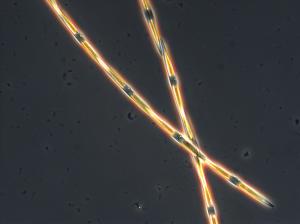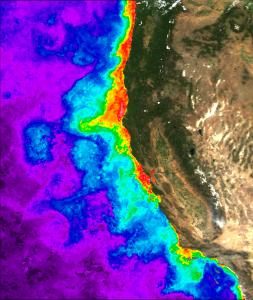Genes in the algae Pseudo-nitzschia genus have been identified that act as a warning beacon for a dangerous neurotoxin
We are witnessing a barrage of highly toxic and impactful domoic acid events in California, creating an urgent need for better predictions and forewarning that a harmful algal bloom is imminent...”
LA JOLLA, CA, UNITED STATES, September 19, 2024 /EINPresswire.com/ -- A team of researchers from the J. Craig Venter Institute (JCVI), Scripps Institution of Oceanography at the University of California San Diego, and collaborators, have published a groundbreaking study on predicting harmful algal blooms (HABs) that contain high levels of the neurotoxin domoic acid. The study provides new insights into the mechanisms driving this type of HAB and offers potential solutions for predicting and mitigating their impacts. — Clarissa Anderson, Ph.D., Scripps Oceanography
In 2015, the largest recorded HAB occurred in the Northeast Pacific, causing nearly $100 million in damages to fisheries and killing many protected marine mammals. During blooms like this, shellfish—such as clams, mussels, and scallops—filter-feed on algae and accumulate the toxin in their tissue. Contaminated shellfish are dangerous to humans when consumed, causing amnesic shellfish poisoning. The toxin cannot be detected by look or taste.
“We are witnessing a barrage of highly toxic and impactful domoic acid events in California, creating an urgent need for better predictions and forewarning that a harmful algal bloom is imminent,” said Clarissa Anderson, Ph.D., director of the Southern California Coastal Ocean Observing System at Scripps Oceanography and study co-author. She continued, “We are now able to rapidly detect toxin production in Pseudo-nitzschia cells, creating a window into the future, rather than relying on time-intensive processing of thousands of volunteer samples from across the state.”
It was during the 2015 HAB that researchers collected water samples from Monterey Bay, off the coast of California, on a near-weekly basis over the course of a year, recording available nutrients and domoic acid concentrations for this study.
Lead co-first author John K. Brunson, a Ph.D. student at Scripps Oceanography and JCVI, and others published a related study in 2018, which implicated a gene called dabA—found in a type of algae known as diatoms in the genus Pseudo-nitzschia—in the production of domoic acid. While they discovered the genetic mechanism for production, they did not understand the biological or environmental drivers involved.
“After our initial discovery of the genes encoding domoic acid biosynthesis, we wanted to see if we could apply this molecular information to harmful algal bloom monitoring. Could we correlate gene activity to toxin production in the marine environment, and if so, did these genes have any predictive power?” said Brunson.
By using the data collected over a year of water sampling in the bay, the team was able to lay a convincing framework for understanding environmental drivers of domoic acid production. In reflecting on this, lead co-first author Monica Thurkral, a Ph.D. student at Scripps Oceanography and JCVI said, “Synthesizing the data was a challenge. We eventually began to realize, however, that the strongest predictors of domoic acid production involved expression of the dabA gene in combination with other genes diagnostic of diatom nutrient physiology.”
By analyzing the transcriptome—the complete set of RNA transcripts produced by an organism—along with environmental factors, researchers were able to tease out how and why Pseudo-nitzschia were thriving and producing domoic acid where other types of diatoms were struggling. Results revealed they have a few adaptations that allow them to outcompete other diatoms in certain conditions.
While these conditions are driven by currents and other factors, it is important to understand the link between overall nutrient availability and atmospheric carbon dioxide (CO2). Extensive research has shown that the ocean absorbs about 30% of the CO2 released into the atmosphere, leading to a decrease in pH, making the ocean more acidic. Ocean acidification affects the availability of both iron and silicon, key elements for diatom survival.
When a diatom dies, its outer shell, which is made of silica, is released back to the ocean, breaks down, and is made available as building blocks for new diatoms. As ocean pH drops, it affects the solubility of the diatom shells, trapping the silica in deeper waters, lowering its overall availability. An additional related study by Scripps Oceanography and JCVI researchers showed that a key diatom iron uptake pathway is impaired by ocean acidification.
Low iron and silicon depress the populations of many types of diatoms. However, in this nutrient impoverished environment, Pseudo-nitzschia persists by “up regulating” a gene called sit1, to draw more of the scarce silicon resource, as well as genes responsible for iron uptake. While this allows them to proliferate it also promotes domoic acid production.
To this point, Andrew Allen, Ph.D., senior study author and professor at JCVI and Scripps Oceanography said, “It turns out that previously unrecognized iron limitation was likely a major factor in promoting the extreme toxicity of the 2015 bloom. This is significant because we also know that ocean acidification from increasing levels of atmospheric carbon dioxide is resulting in diatom iron stress.”
Further, they noticed that when the dabA gene is elevated, so is sit1. The co-expression of the dabA and sit1 genes serve as a robust predictor of domoic acid events one week in advance of them occurring. As these genes become more active, a bloom is about to become toxic.
“In many ways, the expression profile of the dabA gene can be viewed as a warning signal that toxin will soon be synthesized and released by the diatom. The better that we can detect dabA in the ocean environment, the better we can pinpoint where and when the next domoic acid toxic bloom will take place, whether in California or elsewhere in the world.” added Bradley Moore, Ph.D., co-author and professor at Scripps Oceanography.
The study team also included researchers from Monterey Bay Aquarium Research Institute, University of California at Berkeley, University of Southern California, University of Malaya, University of California-Santa Cruz, Moss Landing Marine Laboratories, and University of California San Diego.
The complete study, “Molecular Forecasting of Domoic Acid during a Pervasive Toxic Diatom Bloom,” may be found in the journal PNAS. The work was funded by the National Oceanic and Atmospheric Administration (grant NA19NOS4780181), National Science Foundation (grants OCE-1756884, OCE-2224726, and IOS-2103715), and the Simons Foundation Collaboration on Principles of Microbial Ecosystems (PriME) grant 970820.
About J. Craig Venter Institute
The J. Craig Venter Institute (JCVI) is a not-for-profit research institute in Rockville, Maryland and La Jolla, California dedicated to the advancement of the science of genomics; the understanding of its implications for society; and communication of those results to the scientific community, the public, and policymakers. Founded by J. Craig Venter, Ph.D., JCVI is home to approximately 120 scientists and staff with expertise in human and evolutionary biology, genetics, bioinformatics/informatics, information technology, high-throughput DNA sequencing, genomic and environmental policy research, and public education in science and science policy. JCVI is a 501(c)(3) organization. For additional information, please visit www.jcvi.org.
Matthew LaPointe
J. Craig Venter Institute
+1 301-795-7918
email us here
Visit us on social media:
Facebook
X
LinkedIn
Instagram
YouTube
Other
Legal Disclaimer:
EIN Presswire provides this news content "as is" without warranty of any kind. We do not accept any responsibility or liability for the accuracy, content, images, videos, licenses, completeness, legality, or reliability of the information contained in this article. If you have any complaints or copyright issues related to this article, kindly contact the author above.



